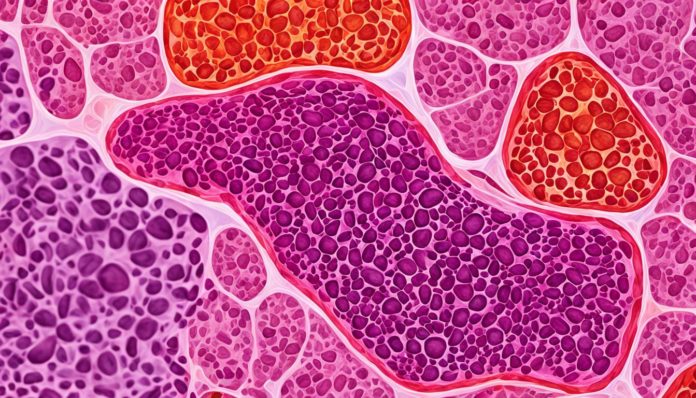In 2019, nearly 174,650 new cases of prostate cancer were found in the United States. Most of these cases were localized, meaning the cancer was only in the prostate gland. This type of cancer is more common in men over 55, especially in African-Americans and less in Asian men.
As people live longer and PSA tests become more common, more localized prostate cancer is found. Knowing about this slow-growing cancer is important. It helps doctors find the best treatments and care plans for patients.
Key Takeaways
- Localized prostate cancer is confined within the prostate gland.
- It predominantly affects men over the age of 55.
- African-American men have higher incidence rates, whereas Asian men have lower rates.
- Early diagnosis is often due to increased PSA screenings.
- Understanding its characteristics and stages is key to effective treatment and management.
What is Localized Prostate Cancer?
Localized prostate cancer means the cancer is only in the prostate gland. It’s key to catch it early for better treatment, especially for men over 66.

Definition and Key Characteristics
Localized prostate cancer is in stages T1/2/early T3, N0, M0. This means it hasn’t spread beyond the prostate to other areas. Men with this stage have a good chance of survival and many treatment options.
Knowing what localized prostate cancer looks like helps catch it early.
Clinical Presentation and Diagnosis
In the early stages, prostate cancer symptoms might be mild or not there at all. Regular tests, like the PSA test, are crucial for catching it early. Doctors use imaging to see if the cancer is just in the prostate.
Understanding localized prostate cancer’s early stages is key. African-American men, especially those with West African roots, should watch closely as they face a higher risk.
Localized Prostate Cancer Definition
Localized prostate cancer means the cancer is only in the prostate gland and hasn’t spread. It’s usually in stages T1 or T2. In stage T1, the cancer is tiny and can’t be found by exams or scans. Stage T2 means the cancer is bigger but still inside the prostate.
The Localized Prostate Cancer Definition looks at PSA levels, Gleason score, and tumor size. These help figure out the Prostate Cancer Prognosis. The Cancer of the Prostate Risk Assessment (CPRA) uses these to put cancer into groups from CPG 1 to CPG 5. CPG 1 is the least aggressive, and CPG 5 is more likely to get worse.

Here’s a table that shows the different groups and what they mean for localized prostate cancer:
| CPG Group | PSA Level | Gleason Score | Tumor Size |
|---|---|---|---|
| CPG 1 | <10 ng/mL | ≤ 6 | T1-T2a |
| CPG 2 | 10-20 ng/mL | 7 | T2b |
| CPG 3 | >20 ng/mL | 7 | T2c |
| CPG 4 | >20 ng/mL | 8 | T1-T2 |
| CPG 5 | Any Level | 9-10 | T1-T2 |
Knowing about Localized Prostate Cancer Definition and its groups helps with treatment choices. It affects the Prostate Cancer Prognosis.
Epidemiology of Localized Prostate Cancer
Understanding localized prostate cancer’s spread is key to fighting it. The Prostate Cancer Global Incidence varies a lot by region and group. African-American men in the U.S. have the highest rates, while Asian men in Asia have the lowest. This shows how culture, genes, and environment affect prostate cancer.
Global Incidence Rates
The Prostate Cancer Global Incidence changes a lot around the world. The U.S. has more cases because of widespread PSA tests. But, in poor countries, there are fewer cases because of less healthcare and no routine tests. This shows we need equal healthcare to catch prostate cancer early.
Risk Factors and Demographics
Many things increase the chance of getting localized prostate cancer. Being over 50, having a family history, race, and lifestyle choices matter. For example, men over 50 and those with a family history are more at risk.
There’s also a big difference in risk by race, with African-American men at higher risk. Diet, being overweight, and smoking also affect your risk.
By focusing on these risk factors and encouraging regular tests, we can lessen the effect of prostate cancer.
Prostate Cancer Staging and Classification
Understanding how to stage and classify prostate cancer is key to finding the best treatments. The TNM and Gleason Score systems are used for this purpose. They give insights into how fast the cancer might grow and spread.
TNM Staging System
The TNM Staging System is a common method for prostate cancer staging. It looks at three main parts:
- Tumor (T): This shows the size and spread of the main tumor in the prostate.
- Nodes (N): It checks if the cancer has reached nearby lymph nodes.
- Metastasis (M): This part sees if the cancer has spread to other body parts.
By combining these, doctors can stage the cancer accurately. This helps in making treatment plans and predicting outcomes.
Gleason Score and Grade Group
The Gleason Score is also crucial in prostate cancer staging. It’s based on a biopsy of prostate tissue. The score goes from 6 to 10, based on the cancer cells’ patterns.
Here’s how the Gleason Score relates to Grade Groups:
| Gleason Score | Grade Group | Description |
|---|---|---|
| 6 | 1 | Low chance of spreading; not very aggressive. |
| 7 (3+4) | 2 | At moderate risk; somewhat aggressive. |
| 7 (4+3) | 3 | More at risk than Grade Group 2; more aggressive. |
| 8 | 4 | High risk; very aggressive cancer. |
| 9-10 | 5 | Very high risk; extremely aggressive cancer. |
Using the Gleason Score and TNM Staging System together gives a full view of the cancer. This helps in making treatment plans tailored to each patient, leading to better outcomes.
Symptoms of Early-Stage Prostate Cancer
Knowing the Prostate Cancer Symptoms is key for catching it early. Early on, prostate cancer can be quiet, with no clear signs. But as it grows, men may notice symptoms that shouldn’t be ignored. These include:
- Difficulty in urinating, including a weak flow or needing to urinate frequently, especially at night.
- Blood in urine or semen, which can be alarming and warrants prompt medical attention.
- Discomfort in the pelvic area, often manifesting as pain or stiffness.
Early detection is crucial for managing prostate cancer well. Regular health check-ups and knowing these Prostate Cancer Symptoms help catch it early. This can lead to better treatment results and a better life.
Being proactive about health is vital, especially with these symptoms. By spotting early signs, people can get the right tests and a treatment plan that fits their needs.
Diagnosis of Localized Prostate Cancer
Diagnosing localized prostate cancer requires a detailed approach. It uses several tools to detect and confirm the condition. Let’s look at the main methods used for this purpose.
Prostate-Specific Antigen (PSA) Test
The Prostate Cancer PSA Test is key in finding prostate issues early. High PSA levels in blood can mean prostate cancer is present. This test helps find men who need more tests to check their risk.
Digital Rectal Exam (DRE)
The Digital Rectal Exam (DRE) works with the PSA test. Doctors can feel the prostate gland for any unusual areas during this exam. Finding lumps or hard spots might mean a Prostate Cancer Diagnosis is needed. The DRE is a crucial part of diagnosing prostate cancer.
Biopsy and Imaging
If PSA test and DRE results are concerning, a Prostate Cancer Biopsy is done. This involves taking small tissue samples from the prostate to check for cancer cells. Imaging like MRI or TRUS helps guide the biopsy and shows detailed prostate images.
Treatment Options for Localized Prostate Cancer
Patients with localized prostate cancer have many prostate cancer treatment options. These include non-invasive monitoring and more invasive surgeries and radiation. The choice depends on the patient’s risk level and health.
Active Surveillance
For men with low-risk prostate cancer, active surveillance might be suggested. This means watching the cancer without treating it right away. Patients get regular prostate-specific antigen (PSA) tests, digital rectal exams (DRE), and biopsies to check if the cancer is growing.
Surgery
Prostate Cancer Surgery often means a radical prostatectomy. This is the removal of the prostate gland and some nearby tissues. Patients can choose between traditional open surgery or robotic-assisted surgery. The latter is more precise and might have fewer complications.
Radiation Therapy
Radiation Therapy for Prostate Cancer uses high-energy rays to kill cancer cells. There are two main types: external beam radiation therapy (EBRT) and brachytherapy. Brachytherapy involves putting radioactive seeds directly into the prostate.
Potential Side Effects
Every prostate cancer treatment option has possible side effects. Prostate Cancer Surgery might cause incontinence and erectile dysfunction. Radiation Therapy for Prostate Cancer could lead to bowel problems and tiredness. It’s important to talk about these risks with a doctor before deciding on a treatment.
Prognosis and Survival Rates
The outlook for localized prostate cancer is usually good, especially when caught early and treated quickly. Many things affect how well someone with prostate cancer will do, like Gleason scores, PSA levels, and the cancer’s stage when found. It’s important for doctors and patients to know these things to plan the best treatment.
Factors Affecting Prognosis
Important things that change the outlook for localized prostate cancer are the Gleason score, PSA levels, and the tumor’s details. High Gleason scores and high PSA levels mean the cancer might be more aggressive, needing stronger treatment. The patient’s health, age, and overall condition also matter a lot in predicting outcomes. Tools like the Predict Prostate tool help give personalized forecasts.
Survival Statistics
Survival rates for localized prostate cancer look promising. The 5-year survival rate is almost 100%, says the SEER database. These numbers are based on big groups and might not tell exactly what will happen to one person. It’s key to look at other factors too when understanding these stats. For more info, check out the American Cancer Society’s website.
FAQ
What is localized prostate cancer?
Localized prostate cancer means the cancer is only in the prostate gland. It’s in the early stages, with no spread to other areas.
What are the key characteristics of localized prostate cancer?
This type of cancer grows slowly and usually affects men over 66. African-American men face a higher risk. It’s often found through PSA tests and imaging showing the cancer is still in the prostate.
How is localized prostate cancer diagnosed?
Doctors use PSA tests, Digital Rectal Exam (DRE), and imaging like MRI or TRUS to diagnose it. They confirm it by looking at tissue samples.
What are the clinical presentations and symptoms of early-stage prostate cancer?
Early prostate cancer might not cause symptoms. But, symptoms can include urinary problems, pelvic pain, and other signs that mean you should see a doctor.
What are the global incidence rates for localized prostate cancer?
Rates vary by region. They’re highest in African-Americans in the U.S. and lowest in Asian men in Asia. PSA tests have changed these rates, especially in wealthy countries.
What are the risk factors and demographics associated with localized prostate cancer?
Being over 55, African-American, or having a family history increases your risk. It’s most common in African-American men, especially those from West Africa.
How is prostate cancer staged and classified?
The TNM system and Gleason scores help stage prostate cancer. TNM looks at invasion and metastasis. Gleason scores measure how aggressive the cancer is based on its cells.
What is the TNM staging system for prostate cancer?
The TNM system checks the cancer’s size, lymph node involvement, and metastasis. This helps guide treatment and predict outcomes.
What is the Gleason score, and how does it affect prostate cancer management?
The Gleason score rates cancer’s aggressiveness by its cell patterns. Higher scores mean more aggressive cancer, which affects treatment choices.
What are the treatment options for localized prostate cancer?
Options include watching and waiting for low-risk cases, surgery, and radiation for higher-risk cases. Treatment choices consider side effects and quality of life.
What is active surveillance in the context of prostate cancer treatment?
Active surveillance means watching the cancer without treating it right away. It’s for low-risk cases to avoid unnecessary treatment and side effects.
What surgical options are available for treating localized prostate cancer?
Surgery can remove the entire prostate gland. It’s often used for higher-risk cases to get rid of the cancer completely.
How is radiation therapy used in the treatment of localized prostate cancer?
Radiation therapy uses high-energy rays to kill cancer cells in the prostate. It’s an option instead of surgery for some patients.
What are the potential side effects of prostate cancer treatments?
Side effects can include urinary issues, erectile dysfunction, bowel problems, and discomfort. Treatment plans aim to balance these risks with benefits.
What factors affect the prognosis of localized prostate cancer?
Prognosis depends on Gleason scores, PSA levels, cancer stage, and overall health. Early detection often leads to better outcomes.
What are the survival rates for localized prostate cancer?
Survival rates are high for localized prostate cancer, especially when caught early. Tools like the Predict Prostate tool help predict survival chances for better decisions.


